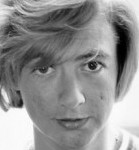Monday, October 27th, 2014 by
In 1954, a novella written by an eighteen-year-old took the French literary world by storm. Called “Bonjour Tristesse” (French: “Hello Sadness”), the ‘amoral’ story of a schoolgirl’s summer romance with an older university student, brought the author, Francoise Sagan, scandalous success. A best-selling novel, “Bonjour Tristesse” made Sagan independently wealthy.
While the title was taken from a poem by Paul Éluard, the story is about disillusioned bourgeois characters and their unconventional romantic afflictions—strong themes also found in many of Sagan’s later works. The novel is narrated by Cecile, a seventeen-year old hedonist who lives with her widowed father and carries a love affair with a handsome law student. Their romance is disrupted by the unexpected arrival of an older woman to whom her father takes a fancy. The newcomer shatters Cecile’s self-indulgent haze, and tries to put the family on a more moral path. Cecile then plans to restore the former disorder by devising a plot that involves her boyfriend and her vain father’s younger ex-flame. The plan works, but it results in the death of the her father’s fiancé.
The youngest of three children, Sagan was born as Francoise Quoirez in Cajarc, and was a habitual rule-breaker in her Catholic school. After her first flush of literary success, Sagan remained in the news for her gambling and exorbitant spending, high-profile relationships and for driving around in sports cars without a care in the world. She was, in short, a literary rock star who lived life on her own terms.
A voracious reader, she adored Proust, and took her nom de plume from his most prominent work, “In Search For Lost Time.” In the summer of 1953, she decided to forgo the annual family holiday to try and study for a retake of her baccalaureate. While much studying was done, she did acquire the habit of spending several hours per day writing in her blue exercise book. “I had a strong desire to write and some free time,” said the accomplished author of her debut. “Instead of leaving for Chile with a band of gangsters, one stays in Paris and writes a novel. That seems to me the great adventure.” She completed the novel in two months and sent it to a publisher.
To her surprise, Julliard agreed to publish it, and the contract authorized an advance of 50,000 francs. “While I was writing I thought there might be a chance of its being published. Finally, when it was done, I thought it was hopeless. I was surprised by the book and by myself.” And the rest as they say, is history.
The book was translated into 20 languages, sold 2 million copies and was made into a 1958 movie directed by Otto Preminger, starring Jean Seberg, David Niven and Deborah Kerr.
John Updike, writing in The New Yorker twenty years after “Bonjour Tristesse” appeared, praised “its sparkling sea and secluding woods, its animal quickness, its academically efficient plot, its heroes and heroines given the perfection of Racine personae by the young author’s innocent belief in glamour.” In the month of publication, Paris-Match called her “an 18-year-old Colette”. Within weeks she had won the important Prix des Critiques, and acclaim was arriving from surprising quarters. The 68-year-old François Mauriac, the reigning Nobel laureate, wrote about her on the front page of Le Figaro.
However, not all sang praises. The chief literary critic of Le Monde, the poet and novelist Émile Henriot, dismissed Sagan’s effort as “immoral.” In Sagan’s view, the disapproval could be explained in terms of the codes of a still predominantly Catholic country. “It was inconceivable that a young girl of 17 or 18 could make love, without being in love, with a boy of her own age, and not be punished for it,” she wrote 30 years later. “People couldn’t tolerate the idea that the girl should not fall madly in love with the boy, and not be pregnant by the end of the summer. It was unacceptable, too, that a young girl should have the right to use her body as she will, and derive pleasure from it without incurring a penalty.”
Written in a candid but effective style, “Bonojour Tristesse” became a dominant image of the disillusioned post-war generation in France. Sagan gave birth to an era, just like Scott Fitzgerald who gave a dream to the American youth; also like Salinger’s Holden Caulfield, her female character gave a voice to teens with slightly-off moral compasses.
Over the course of a long and eventful career, Sagan went on to produce 20 novels, three volumes of short stories, nine plays, two biographies and several collections of non-fiction pieces on places, things and people she loved. Like all success stories, the beginning was simple enough—“I simply started it. I wasn’t thinking about ‘literature’ and literary problems, but about myself and whether I had the necessary willpower.”
References:
http://www.theguardian.com/books/2014/feb/28/francois-sagan-bonjour-tristesse>
http://www.theparisreview.org/interviews/4912/the-art-of-fiction-no-15-francoise-sagan>
Subscribe
Sorry, there are no posts.





